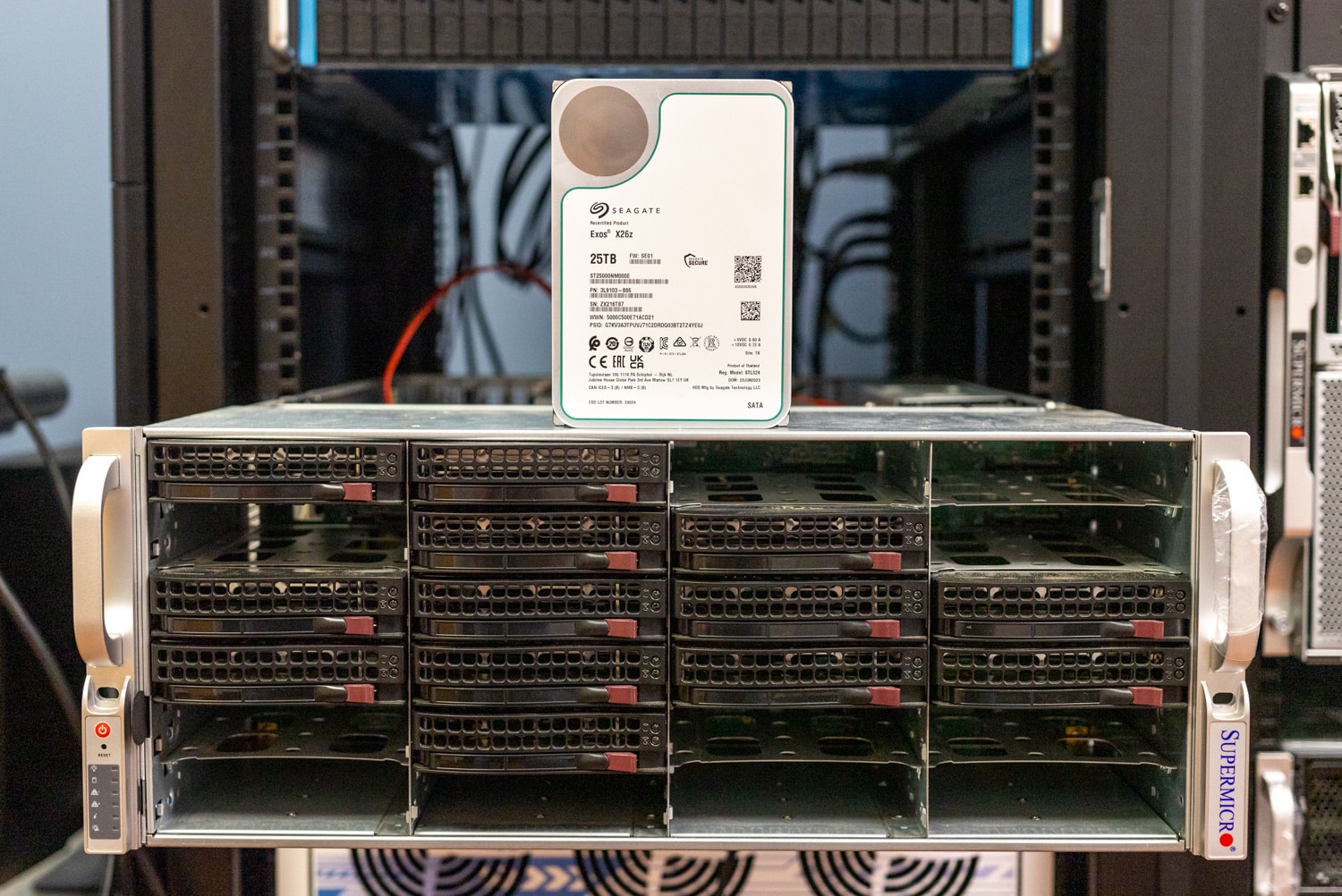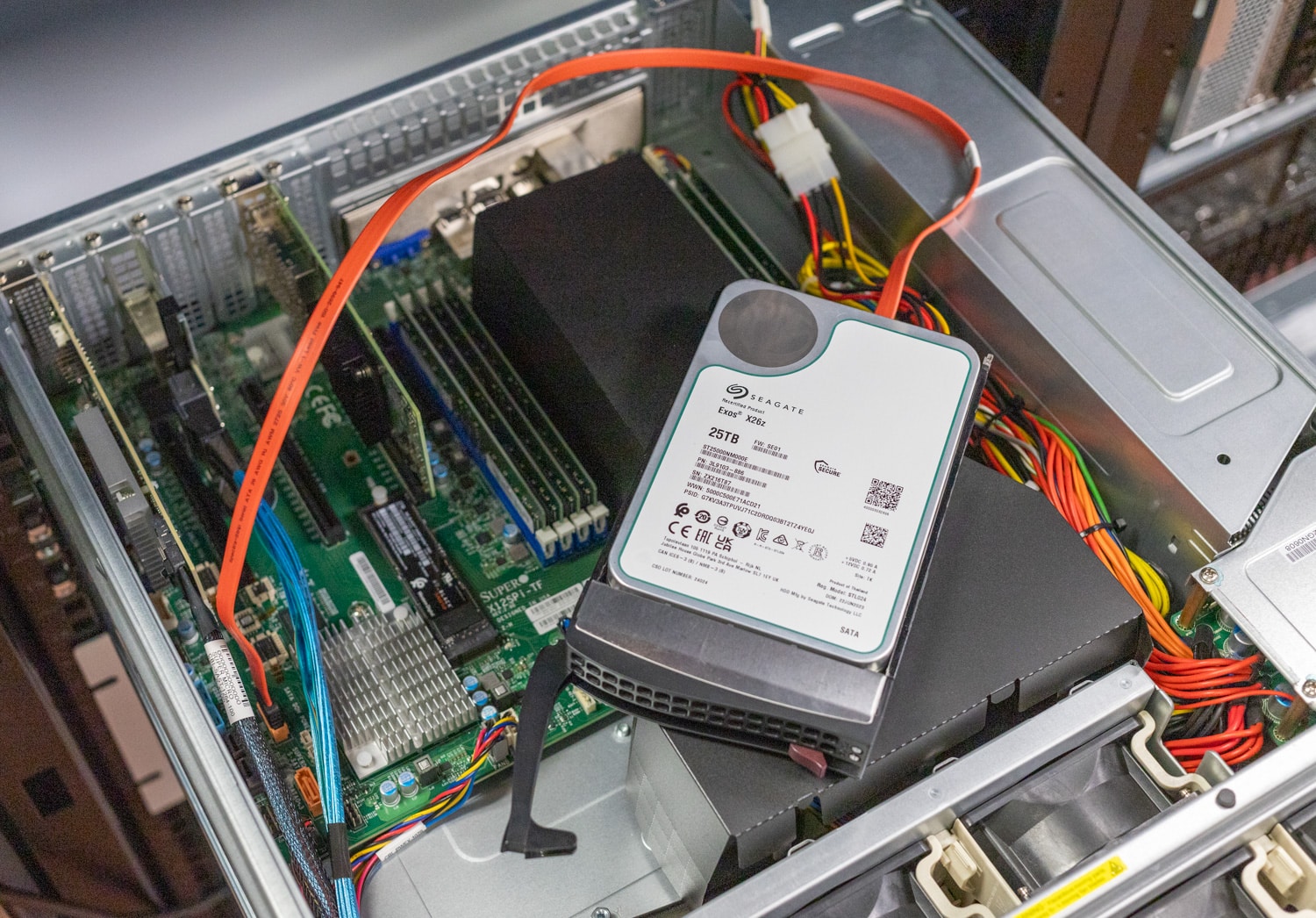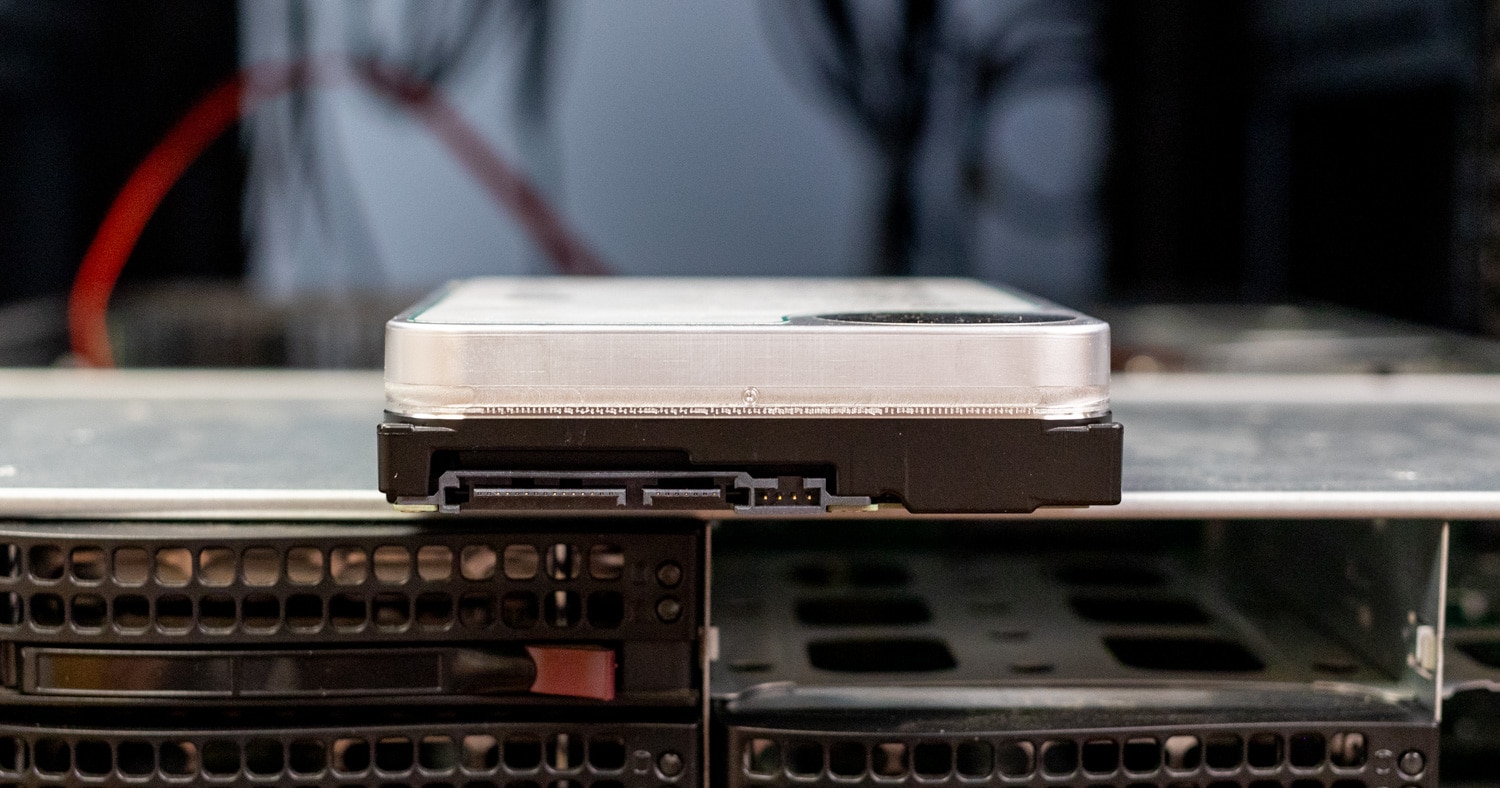The Seagate Exos X26z is a host-managed SMR hard drive, created exclusively for Seagate’s largest customers who control their stacks and can take advantage of these specialized, high-capacity drives. A word of warning though, don’t try this at home!
There’s a special category of hard drives designed to give hyperscalers and other cloud providers the most capacity possible per 3.5″ drive slot. Shingled magnetic recording (SMR) hard drives started out by layering tracks to give HDD vendors more capacity per platter. There are performance considerations though and some nuance in how these drives need to be interacted with. Further, there’s a class of SMR drives that are host-managed (HM-SMR), which gives the host system more control over data placement. The Seagate Exos X26z is one of these drives, created exclusively for Seagate’s largest customers who control their stacks and can take advantage of these specialized hard drives.
Seagate Exos X26z High-Level Specs
| Attribute | Value |
|---|---|
| Type | 25TB Enterprise Hard Drive |
| Brand | Seagate |
| Series | Exos X26z |
| Model Number | ST25000NM000E |
| Drive Type | Zoned Storage Device, Host-Managed SMR |
| Form Factor | 3.5″ |
| Capacity | 25TB |
| Interface | SATA 6Gb/s |
| Spindle Speed | 7.2K RPM |
Seagate Exos X26z – How Did We Get Here?
Because of the limited market for HM-SMR HDDs, Seagate and WD don’t really sample these for review. And for good reason, typical tech reviewers would slam these into a Windows rig, find the drive doesn’t appear and the review would end before it starts. Yet here we are anyway, with the X26z in hand. As with most of our recent terrible ideas, this one too is thanks to our active, but misguided at times, Discord community.
As they are oft to do, many in our Discord regularly trawl eBay looking for their next aspirational homelab “treasure.” Regarding the case at hand, I made the mistake of encouraging these members, telling them the next odd thing they found, I would buy and review. A few minutes later, I had this hard drive in my eBay cart. $300 later, here we are.
Zoned Storage Device, Host-Managed SMR – Not for Everyone
As I’ve alluded to a few times, these drives have a very small compatibility list. Not only do they require an OS that can work with HM-SMR drives, but they also have a specific (limited) subset of adapters, etc that are compatible. The worst part is because Seagate sells these to a handful, or two, of accounts, they’ve made no effort to publicize much about the product. We found a manual for much older drives but ended up soliciting our friends on social media for the best advice.
The recommendation was to start with Ubuntu, which has had HM-SMR support for a while. The flavor of choice we loaded is 23.04. From there, there was a consistent message that can be summed up as “best wishes guys, you’re probably wasting your time.”
For fun, Kevin started by putting the drive in a Windows system. It wasn’t even recognized as a connected device. Moving on, we dropped it in a Supermicro storage server, with SATA/SAS bays. Surely with Ubuntu installed the drive would be found. Alas, victory escaped our grasp again, drive not found.
With one last try before smashing the drive and disgracefully quitting, Kevin directly cabled the Seagate Exos X26z to the motherboard. One more boot and…it’s there! As it turns out, there are known bugs and issues that prevent making this type of drive visible through certain SAS HBAs and SAS switches that are part of disk expanders. Direct attached SATA mitigates those issues, but there are few SATA ports available on traditional server motherboards.
To be fair to the drive, the customers using these drives have hardware purpose-built to take advantage of them. We don’t, so the trial and error we went through is entirely self-inflicted. It’s also why for the duration of this testing the drive sat precariously balanced on top of the CPU heatsink, thanks to our creative cabling.
Prepping the Seagate Exos X26z for Review
With the drive visible there were a few housekeeping things to attend to. This particular drive came from ServerPartsDeals and is sold as manufacturer-recertified. Recertified is probably a little misleading in this case. Based on our research it looks like these drives were part of an order that didn’t get fulfilled. So technically not “brand new,” but they probably also never suffered from any ailment that required fixing. For future reference, Seagate drives with the green line around the label all fit in the recertified category.
To be sure we had the drive in a clean state, we created a new btrfs filesystem, clearing all existing zones with the following command:
sudo mkfs.btrfs -O zoned -d single -m single /dev/sdX
Running lsblk, we can see the block device, as well as the smaller 20TB IronWolf Pro CMR HDD.
root@bigserver:/home/storagereview# lsblk
sda 8:0 0 18.2T 0 disk
sdb 8:16 0 22.7T 0 disk
By comparison, a 20TB CMR drive shows up as an 18.2TB raw device, whereas the 25TB Exos X26z shows up with a usable size of 22.7TB. We also looked at the drives using parted to see the partition and block layout. The traditional 20TB IronWolf Pro CMR model gives us the usual details showing it is 512-byte compatible while it prefers the 4K block alignment.
Model: ATA ST20000NE000-3G5 (scsi)
Disk /dev/sda: 20.0TB
Sector size (logical/physical): 512B/4096B
Interestingly enough, the 25TB model shows the same information.
Model: ATA ST25000NM000E-3L (scsi)
Disk /dev/sdb: 25.0TB
Sector size (logical/physical): 512B/4096B
Seagate Exos X26z Performance
With the housecleaning out of the way, we turned to fio to hit both drives with really basic four-corner workloads consisting of 128k sequential read and write, as well as 4k random read and write.
| Seagate Exos X26z 25TB | Seagate IronWolf Pro 20TB | |
|---|---|---|
| Sequential 128K Read (4T/32Q) | 274MB/s | 278MB/s |
| Sequential 128K Write (4T/32Q) | 270MB/s | 286MB/s |
| Random 4K Read (4T/32Q) | 2,121 IOPS | 233 IOPS |
| Random 4K Write (4T/32Q) | 2 IOPS Total before failing | 313 IOPS |
While these seem like pretty tame tests, which they are for the CMR HDD, the SMR model completely errors out with random writes applied. This is where host-managed HDDs get a little strange, while the drive-managed SMR HDDs can cope better, albeit with much lower performance.
Also worth noting, the 4K read IOPS figures are impressive. This is consistent with what we’ve seen prior from SMR HDDs, due to the way they lay down tracks. Random reads and writes actually look a lot more like sequential to the drive.
In the end, customers leveraging these HDDs go into it with the full knowledge of building a software stack around the drive to best utilize their benefits (increased capacity, lower cost) and work around the technology limitations. But clearly the drive gets a little wiggly when not created properly, making it less than an ideal fit for anyone that doesn’t manage their stack from the top down.
Final Thoughts
The Seagate Exos X26z and HM-SMR drives like it, have a very specific use case in mind. They’re really useful when a hyperscaler can incorporate the drive’s characteristics into the way they manage data. SMR drives can give these data centers up to 25% more capacity per slot over CMR drives, and SMR has done well to fill the capacity growth gap while we wait for HAMR to come to market in volume.

Image created using OpenAI’s DALL-E, prompted by Jordan Ranous of StorageReview
But alluring as they are, these are not a good investment for most. When a homelabber is cruising eBay looking for cheap high-capacity drives, the 25TB sticker and relatively low cost may lead to a lifted eye brow. I urge you however, keep driving, you don’t want this drive. The painful truth is that it’s a mirage dancing at the edge of reason even the most ardent homelabber should avoid. Just sit back and wait for a more friendly drive to go on sale, surely those 50TB HAMR drives will be out soon too right?
Engage with StorageReview
Newsletter | YouTube | Podcast iTunes/Spotify | Instagram | Twitter | TikTok | RSS Feed



